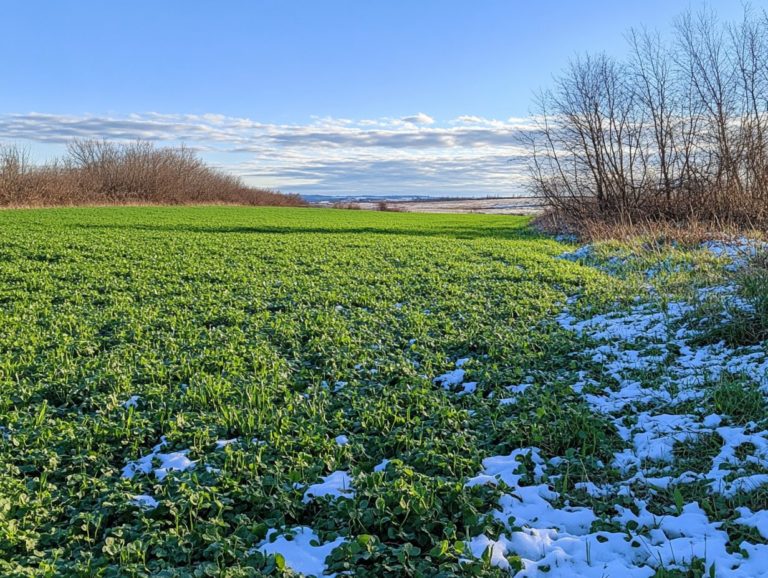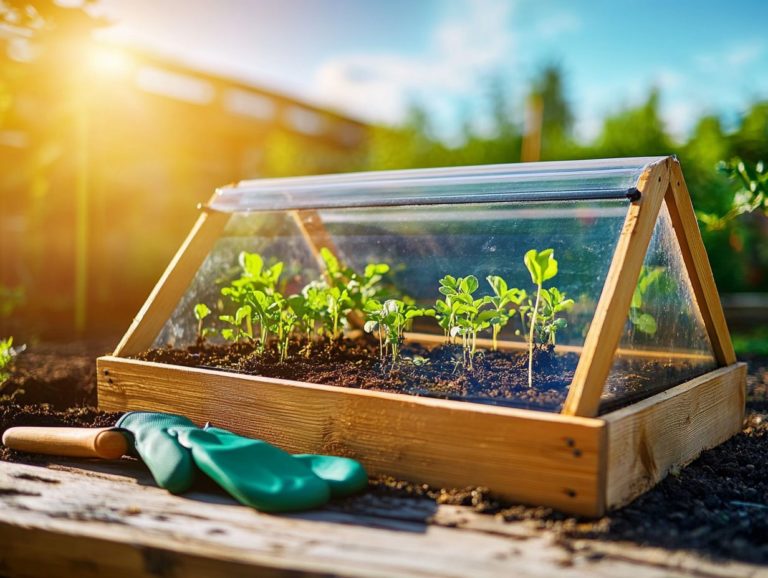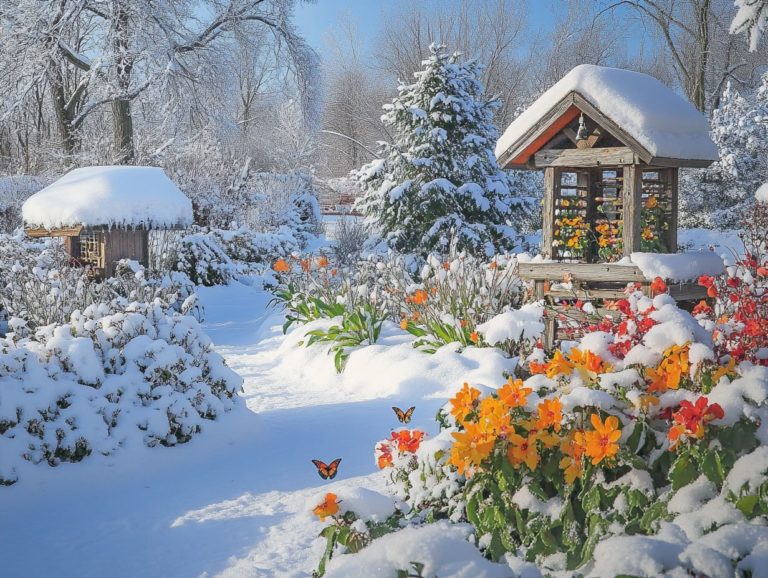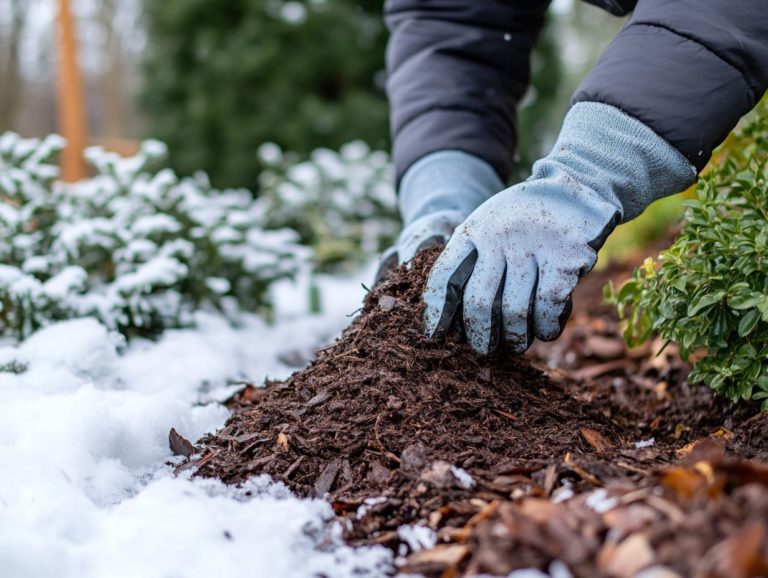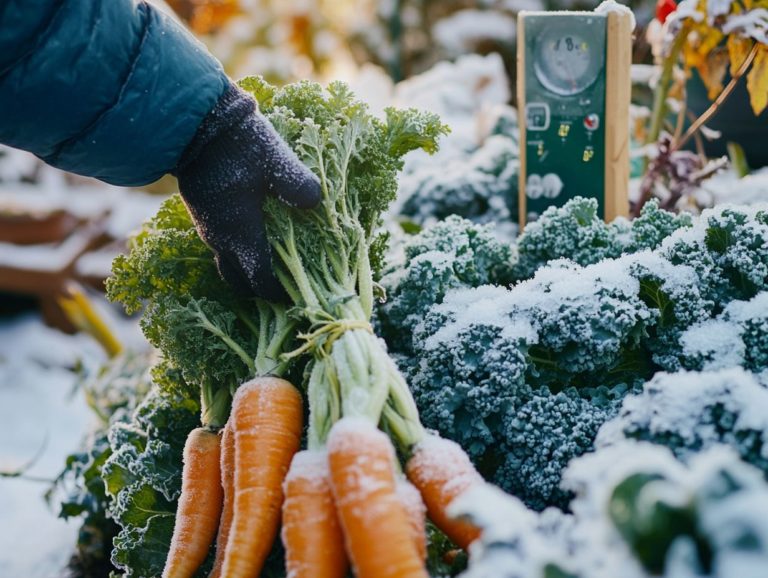How to Grow Microgreens in Winter?
Microgreens are those delightful, tiny plants bursting with nutrients that can elevate your meals to extraordinary levels.
You ll find that cultivating these greens is entirely feasible, even during the chilly winter months. Growing microgreens in winter not only provides you with a fresh source of nutrition but also brightens your space and helps combat the seasonal blues with a touch of vibrant greenery indoors.
This article delves into the myriad benefits of winter gardening, highlights the best varieties to consider, outlines essential supplies, and provides step-by-step tips for a bountiful harvest. Plus, you ll discover some healthy recipes to savor your homegrown microgreens.
Get ready to brighten your winter with vibrant greens! Let s dive in!
Contents
- Key Takeaways:
- Why Grow Microgreens in Winter?
- Choosing the Right Microgreens to Grow in Winter
- Supplies and Equipment Needed
- Step-by-Step Guide to Growing Microgreens in Winter
- Harvesting and Using Winter Microgreens
- Frequently Asked Questions
- Curious about microgreens? Why are they beneficial to grow in winter?
- What are the best microgreens to grow in winter and how to harvest them?
- How do I grow microgreens in winter?
- Do I need special lights or equipment to grow microgreens in winter?
- How long does it take to grow microgreens in winter?
- Can I grow microgreens in any type of container?
Key Takeaways:
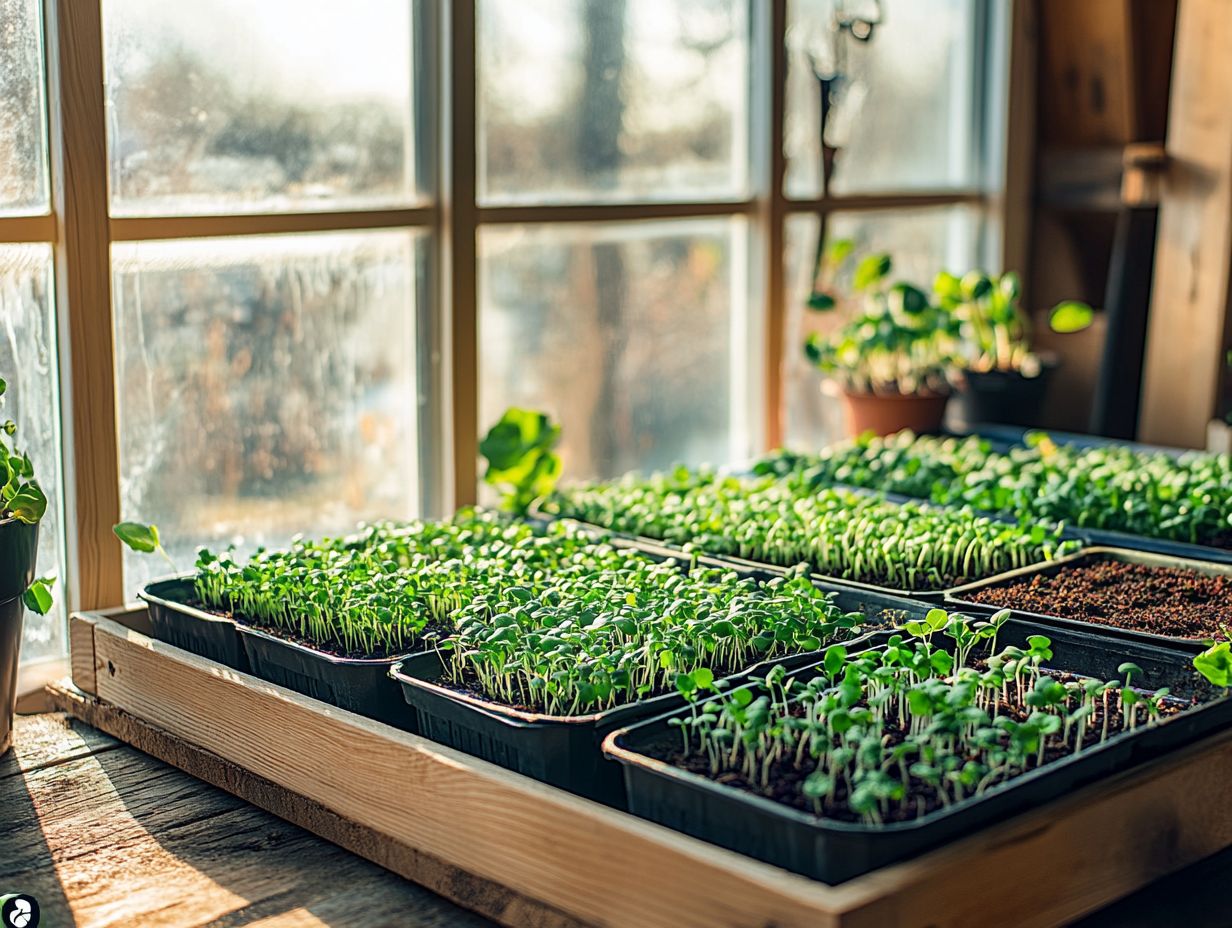
- Grow fresh microgreens indoors all winter!
- Choose cold weather-friendly varieties like kale, radish, and broccoli for a successful winter microgreen garden.
- With the right supplies, equipment, and care, you can easily grow microgreens at home during the winter season.
What are Microgreens?
Microgreens are young, edible plants that you harvest just after their first leaves pop up. They deliver an impressive burst of flavor and a treasure trove of nutrients in a compact package.
These vibrant greens include broccoli, kale, and arugula. They are not only a breeze to grow, but they also pack a serious nutritional punch, making them a go-to for both home gardeners and indoor growing aficionados.
Loaded with vitamins, minerals, and antioxidants, microgreens often boast higher nutrient densities than their fully grown counterparts, allowing you to meet your dietary needs deliciously. While you may be familiar with popular varieties like radish and basil, don’t overlook the exotic options that are gaining traction, such as mustard greens and beet tops. These unique choices can add intriguing flavors and striking colors to your salads and dishes.
Their rapid growth cycle typically within just 7 to 21 days makes them perfect for instant gardening satisfaction. Whether you cultivate them on a sunny windowsill or in a soil-less growing method that uses nutrient-rich water, these nutrient-dense greens can truly elevate your meals, proving themselves as both a culinary delight and a nutritional powerhouse.
Why Grow Microgreens in Winter?
Growing microgreens in winter presents a distinct opportunity for you to savor fresh and nutritious greens, regardless of the frosty weather outside. Learning how to make use of vertical gardening in winter is an excellent choice for gardening in small spaces and indoors.
With their rapid growth cycle and outstanding nutritional benefits, microgreens can elevate your winter meals and contribute to a healthy diet, even when outdoor gardening options are limited.
Benefits of Winter Microgreen Gardening
Winter microgreen gardening offers you a wealth of advantages, such as effortless growth, access to fresh produce year-round, and the impressive health benefits of nutrient-dense greens like radish and kale. Additionally, growing mushrooms in winter can further elevate your meals during the colder months and bolster your wellness by increasing your intake of essential vitamins and minerals.
Growing these greens indoors makes it incredibly convenient for you to cultivate fresh food right in your own home. It s a delightful opportunity for those passionate about nutrition to enrich their diets with varieties like broccoli and arugula. These microgreens are brimming with antioxidants, delivering heightened levels of vitamins A, C, and K crucial for immune support and overall well-being.
The cultivation process is refreshingly simple, requiring minimal space and resources, making winter microgreen gardening an ideal solution for your busy lifestyle. To maximize your efforts, learn how to use a greenhouse in winter gardening, ensuring that even in the chilly months, you have nutritious options readily available at your fingertips.
Choosing the Right Microgreens to Grow in Winter
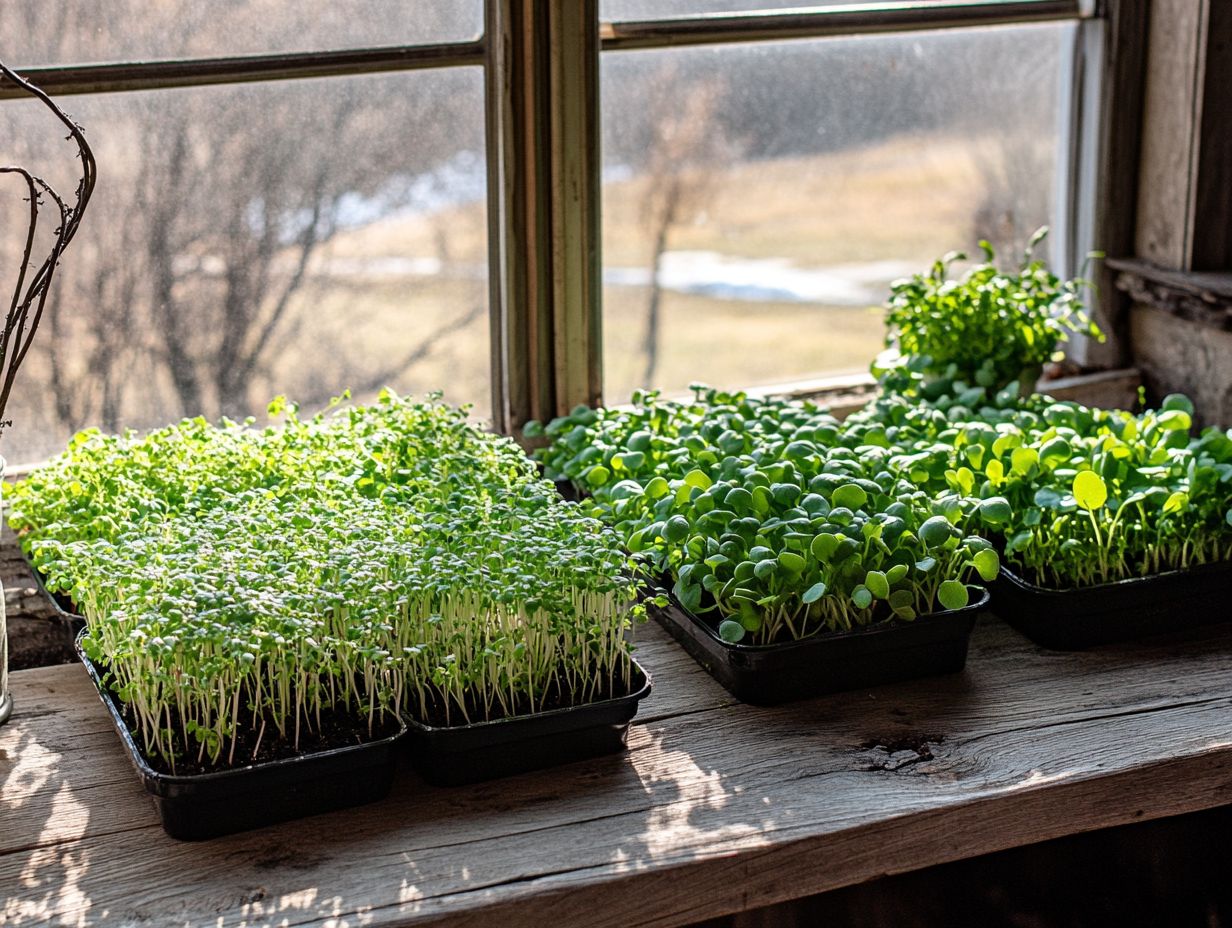
Selecting the right microgreens to grow during winter is essential for maximizing yields, especially when you learn how to start seeds indoors for cold climates. It ensures a consistent supply of fresh greens.
Consider popular choices like kale, broccoli, and arugula. These varieties thrive in cooler temperatures and provide a delightful range of flavors.
By understanding the seed sprouting needs and specific growth conditions for these varieties, you can set yourself up for a successful harvest, even in the coldest months.
Best Varieties for Cold Weather
When cultivating microgreens in cold weather, some of the best varieties are radish, broccoli, and kale. These greens are not just resilient; they also boast rich nutrient profiles.
They thrive in lower temperatures and pack a fantastic flavor, making them perfect for your winter gardening endeavors.
Arugula and Swiss chard offer a peppery taste and vibrant color to your collection. Nutrient-dense mustard greens flourish even in the chill, adding a spicy kick to any dish.
Be bold! Experiment with lesser-known varieties like pea shoots and beet greens for exciting flavors. You can easily sprout any of these microgreens on a windowsill or under minimal grow lights.
This ensures an abundance of vitamins A, C, and K, along with essential minerals. These hardy greens are very adaptable, contributing to a diverse winter harvest while enhancing the nutritional profile of your meals all year round.
Supplies and Equipment Needed
To successfully cultivate microgreens indoors during winter, gather the right supplies and equipment. This includes drainage trays, organic soil, and artificial lights to create optimal growth conditions, as well as following a guide on how to grow a winter salad garden.
These essential tools promote efficient seed germination and enhance the environment for nurturing healthy, vibrant microgreens throughout the colder months.
Essential Tools and Materials
Key tools and materials for cultivating microgreens include seed trays, a watering can, and lightweight soil. These are essential for creating an optimal environment for your plants.
Proper lighting is crucial, as it mimics natural sunlight, fostering vibrant growth that you ll be proud to showcase.
You might also consider using a humidity dome to trap moisture and maintain an ideal microenvironment. A spray bottle offers a gentle method for keeping the soil consistently moist without overwhelming those delicate seedlings.
Quality seeds are paramount, as they significantly influence germination rates and the overall vitality of your microgreens. When combined, these components streamline your growing process and enhance the quality and flavor of the greens, making them a sought-after addition for culinary enthusiasts.
Step-by-Step Guide to Growing Microgreens in Winter
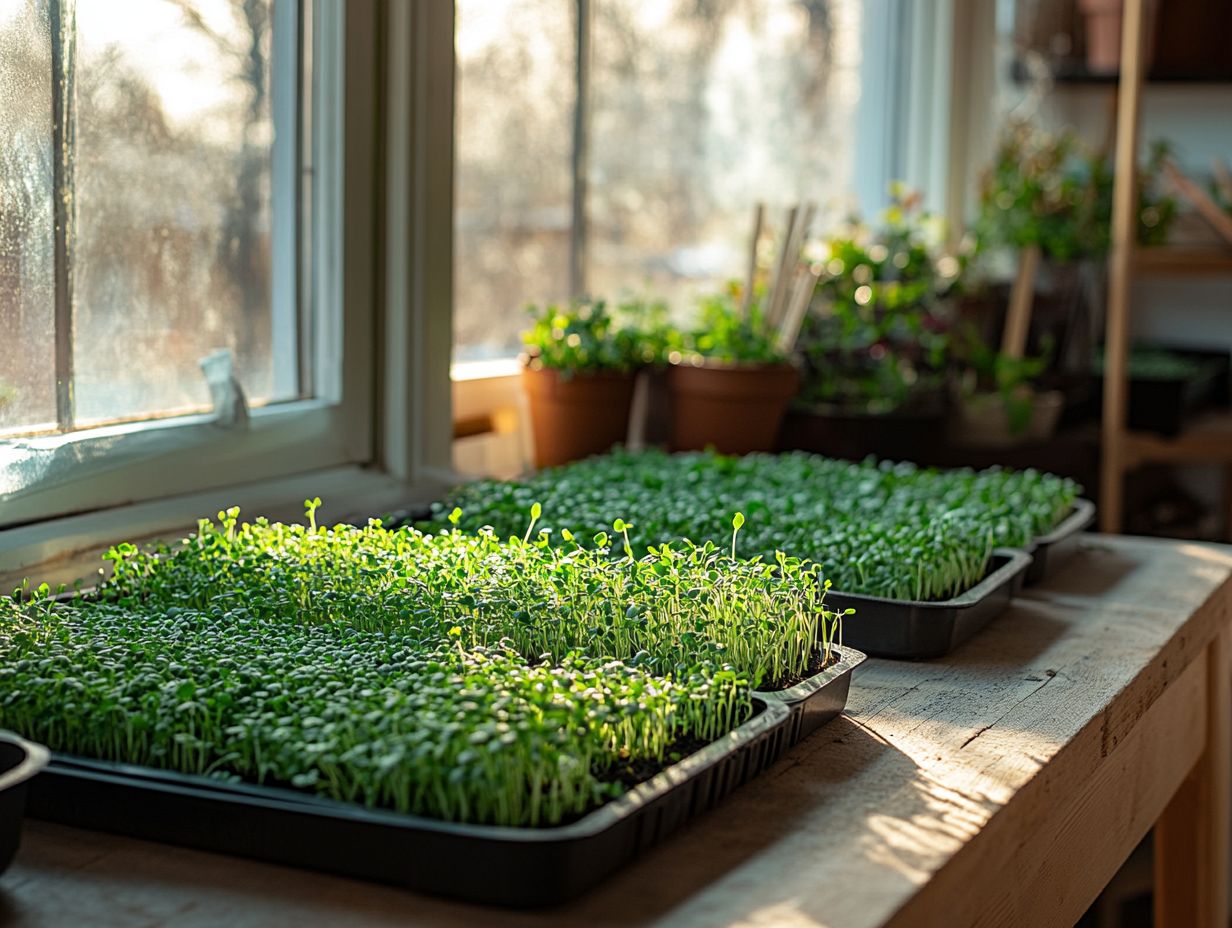
A step-by-step guide to growing microgreens in winter requires meticulous soil preparation, careful watering, and attentive harvesting to achieve optimal growth and flavor. Additionally, you might consider using aquaponics for winter gardening to enhance your results.
By following a clear process that spans from seed germination to harvest, you can enjoy a consistent supply of nutritious and delightful microgreens right from the comfort of your home during the colder months.
Preparation, Planting, and Care Tips
Preparation, planting, and care for microgreens require the right humidity levels. Sticking to a consistent watering schedule and being mindful of light requirements helps foster healthy growth. You’ll be amazed at how easily you can nurture your microgreens, resulting in robust plants that enhance your homegrown produce collection.
Selecting the right planting material is crucial; opt for a seed-starting mix or coconut coir, both of which retain moisture without succumbing to waterlogging.
For optimal light, position your trays where they can bask in 12 to 16 hours of bright, indirect sunlight each day. If natural light is scarce, a grow light is an excellent alternative to ensure your microgreens thrive.
Maintaining humidity levels between 40-60% creates ideal growing conditions. Keep a close eye on soil moisture to prevent your delicate seedlings from drying out or drowning.
By regularly evaluating these factors, you ll ensure a bountiful microgreen garden.
Harvesting and Using Winter Microgreens
Harvesting and utilizing winter microgreens is not just rewarding; it’s a delightful journey into the world of flavor and nutrition. These petite greens can significantly enhance the nutritional profile of your dishes while infusing meals with vibrant flavors.
Whether you incorporate them into salads, blend them into smoothies, or use them as elegant garnishes, microgreens offer a wealth of health benefits and culinary versatility that can truly elevate your home-cooked creations.
Ways to Enjoy Your Homegrown Microgreens
Enjoying your homegrown microgreens can be a delightful experience. Simply add them to salads or use them as garnishes for soups and sandwiches to introduce a burst of flavor and nutrition. These greens are not only versatile but also elevate the presentation of your dishes while packing essential vitamins like E, K, and C.
If you’re looking to enhance your breakfast, consider tossing microgreens into an omelet or smoothie. Just a sprinkle can turn a boring meal into a health-boosting delight. The peppery notes of arugula or the delicate flavor of pea shoots can invigorate any dish.
Incorporating them into wraps or grain bowls not only enhances texture but also injects vibrant color that makes your meal visually appealing.
Microgreens can also serve as a nutritious addition to dips like guacamole or hummus, offering an unexpected yet delightful twist. They re perfect for layering flavors in stir-fries and pizzas, showcasing their culinary versatility.
Frequently Asked Questions
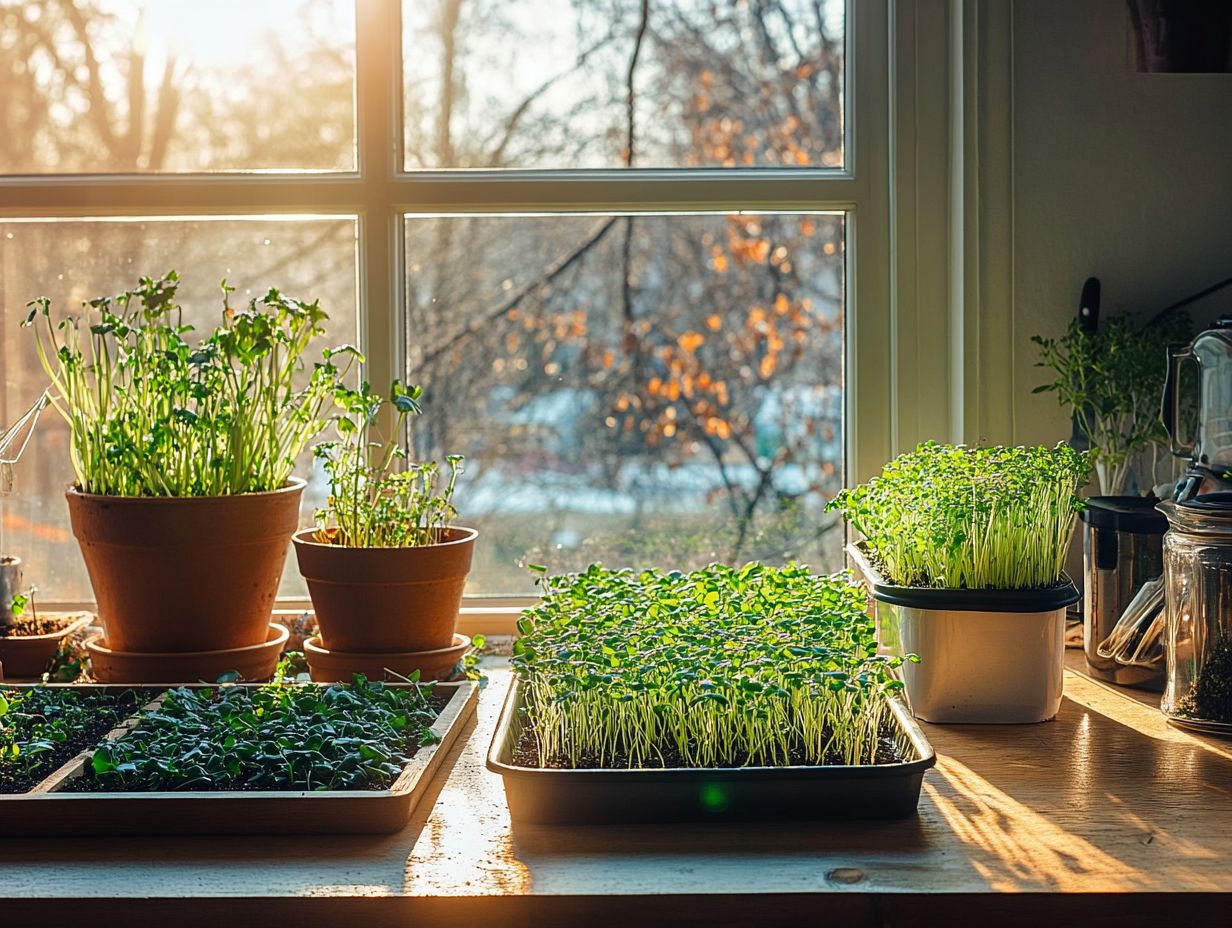
Curious about microgreens? Why are they beneficial to grow in winter?
Microgreens are tiny but nutrient-dense versions of common vegetables and herbs. They are packed with vitamins, minerals, and antioxidants, making them a great addition to any diet. Utilizing vertical gardening in winter allows you to grow microgreens and enjoy fresh, healthy greens even when traditional gardening is not possible due to cold weather.
What are the best microgreens to grow in winter and how to harvest them?
Some of the best microgreens to grow in winter include kale, arugula, broccoli, radish, and mustard greens. These greens are hardy and can tolerate cooler temperatures, making them perfect for indoor winter gardening. If you’re also interested in expanding your winter gardening efforts, consider learning how to successfully grow garlic in winter.
How do I grow microgreens in winter?
To grow microgreens in winter, you will need some basic supplies like soil, containers, and seeds. Using proper techniques can help maximize your yield. Additionally, if you’re interested in expanding your gardening expertise, learning how to grow salad greens in cold climates can offer great insights. For best results, it is important to know energy prices as they can affect your indoor gardening setup.
Do I need special lights or equipment to grow microgreens in winter?
No, you do not need any special equipment to grow microgreens. However, if you do not have access to natural sunlight, you can use a grow light to provide your microgreens with the necessary light they need to grow.
How long does it take to grow microgreens in winter?
On average, microgreens take around 1-2 weeks to fully grow. However, the time may vary depending on the type of microgreen, the quality of the soil, and the amount of light and water it receives. If you are new to growing, consider following guides on harvesting microgreens to ensure optimal yields.
Ready to start growing your own microgreens? Dive into the exciting world of indoor gardening today!
Can I grow microgreens in any type of container?
Yes! You can grow microgreens in almost any container that drains well. Get creative with options like plastic trays, ceramic pots, or even yogurt cups.
Just remember to poke a few holes in the bottom. Container gardening is not only easy but also a fun way to enjoy fresh greens at home!

